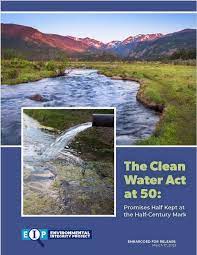 The Clean Water Act at 50: Promises Half Kept at the Half-Century Mark
The Clean Water Act at 50: Promises Half Kept at the Half-Century Mark
From the Environmental Integrity Project, Washington, DC, March 17, 2022
Report to the Nation ~ Conclusions and Recommendations:
There is no question that the federal Clean Water Act should be celebrated in its 50th year as a milestone in American environmental history. The law provided funding for thousands of upgrades to wastewater treatment plants and a significant reduction in raw human waste and industrial discharges pouring into rivers and streams.
To cite one high-profile example, the Potomac River flowing through the nation’s capital was transformed by more than a billion dollars in improvements to the Blue Plains Wastewater Treatment Plant that were required by the Clean Water Act. Today, fishing tournaments, kayak rentals, and waterfront restaurants are now common along Washington’s waterfront where a half century ago there were fetid algae blooms and lifeless waters. Another obvious example is that Cuyahoga River in Ohio. But that river – while no longer flammable – is still impaired because of fecal bacteria from sewage spills that often makes the river unsafe for swimming and water-contact recreation.
Downstream from the Cuyahoga is Lake Erie, which – a half century after the Clean Water Act – is still blanketed many summers by hundreds of square miles of toxic algal blooms. This latter problem reflects a weakness in the Clean Water Act, which provides no controls on fertilizers or manure spread on crop fields in the Ohio countryside.
It is not just Lake Erie that’s still struggling a half century after the Clean Water Act. Across the U.S., streams and rivers are burdened with excessive amounts of toxic algae and pollution. Some of this flows from industries, such as oil refineries, chemical plants, and slaughterhouses, which are allowed to discharge too much because EPA has failed to update technology-based standards for their pollution control systems for decades.
As described in this report, half of America’s assessed river and stream miles – a total of 703,417 miles – are classified as impaired, as are 55 percent of lake acres that have been studied. And these numbers, while staggering on their own, understate the scale of the remaining problems. This is because 73 percent of rivers and streams miles across the U.S. have not been assessed in recent years, and the same is true for almost half of lakes.
So what should be done to solve this problem? What can we do to help the Clean Water Act fulfill its promise of “fishable, swimmable” waters for all Americans – especially communities of color and lower income people, who are often disproportionately burdened with sewage spills and water pollution?
1) EPA needs to do its job and comply with the Clean Water Act’s mandate for more frequent updates of technology-based limits for industry water pollution control systems. Despite a legal mandate for reviews at least every five years and technological advances in wastewater treatment systems, highly-polluting industries like cement manufacturing have not had their standards updated since the 1970s – back when “modern” technology meant Apple II computers with floppy disks.
2) Congress should strengthen the Clean Water Act by closing its loophole for agricultural runoff and other “non-point” sources of pollution, which are by far the largest sources of impairments in waterways across the U.S. Factory-style animal production, in particular, has become an industry with a massive waste disposal problem, and should be regulated like other large industries.
3) EPA or Congress should impose more consistent, universal guidelines for waterway impairment designations for all 50 states, and for gauging unhealthy levels of key pollutants like nitrogen. The clashing patchwork of state methods for monitoring and appraising waterways used today contributes to an ineffective distribution of funding and cleanup efforts.
4) Congress should make it easier to enforce key requirements of the Clean Water Act, including the cleanup plans — called “Total Maximum Daily Loads” — that are supposed to be one the primary mechanisms for reducing the amount of pollution until impaired waterways are restored to health.
5) States are set to receive billions of dollars from Congress’ recent passage of a $1.2 trillion Bipartisan Infrastructure Bill. Governors and lawmakers should, whenever possible, target this funding to water pollution control efforts, especially in lower- income communities of color that have long suffered disproportionately from the dumping of pollution.
6) Congress and the states need to boost funding for the expert EPA and state environmental agency staff required to measure water quality, and to develop and implement the cleanup plans needed to bring impaired waterways back to life.
7) Although achieving the Clean Water Act’s goal of 100 percent “fishable and swimmable” waterways will be challenging, EPA should keep driving toward this target by setting interim goals by decade and by creating specific, enforceable plans to achieve pollution reductions.
Given the gridlock paralyzing Congress, some of these proposed fixes will be an uphill battle. But other important solutions do not require Congressional action – such as by having EPA use its existing authority to update industry-specific technology standards that, by law, should have been modernized decades ago.
And there is no good reason that EPA also can’t impose more uniformity and consistency to the waterway impairment listing practices of the states, which today are disparate and chaotic. This common-sense move toward standardization would make it easier to target federal and state infrastructure improvement funds to cleanup projects where they are most needed.
The Clean Water Act’s promises may still be only half-kept at the half-century mark, but there is no reason we can’t learn from its shortfalls to finally provide clean water to all Americans, as Congress promised five decades ago.
>>> Tom Pelton, Environmental Integrity Project, Director of Communications
Co-Director, EIP Center for Environmental Investigations
1000 Vermont Avenue, Suite 1100, Washington, DC 20005
